Original Kit:
Snow Plow Ford LNT-8000
Made By:
AMT (kit #38687)
Scale:
1/25

eBayPartner Affiliate Link
Other 1970s Movie Models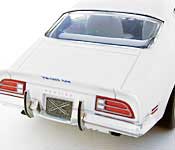
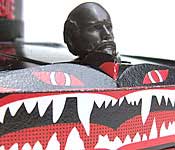
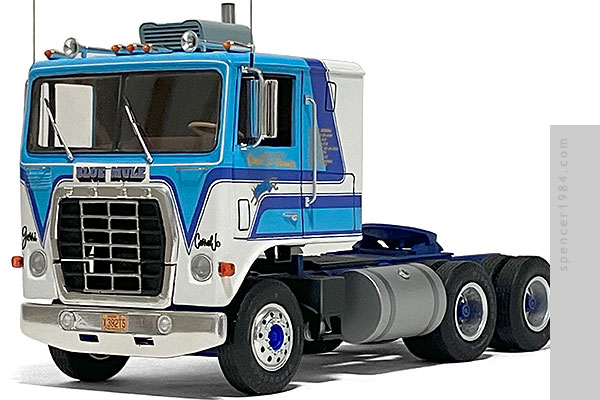
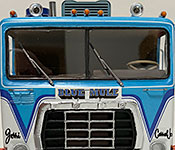
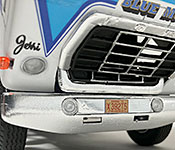
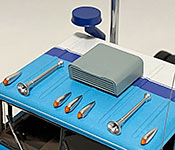
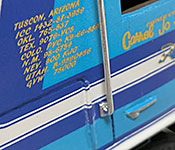
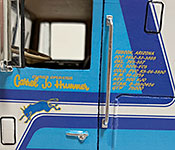

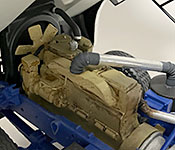
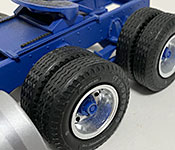
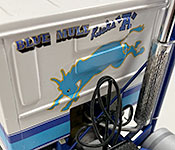
When it was time to build the Blue Mule from White Line Fever, I wanted to start with AMT's snow plow so that it would include the idiosyncracies unique to Ford trucks - the shape of the frame rails, the suspension, etc. The length looked about right, too, with few changes to the basic ladder needed to make it fit the cabover. The kit even included a bunch of semi truck parts that were supposed to be discarded when building it as the plow, saving me some kitbashing.
The frame went together pretty easily, all things considered. These older AMT trucks had their quirks, with sometimes vague instructions and lots of flash and questionable parts fit to work through, but in the end no real problems. The wheels and tires were straight out of the kit, but I used a set of resin rear wheel hubs. It was then painted Krylon's Satin Iris and lightly weathered to reflect its life as a work truck.
The movie truck used a 6-cyl Cummins engine, so I swapped out the Ford V8 with one from my parts box. It fit surprisingly well, with only a little trimming needed around the front pulley to get it to clear. The radiator also came from my parts box, with scratch built supports and hoses to get it all hooked up. It lacked any front side detail, so I used a section of Evergreen clapboard siding to give some texture to it when viewed through the grille. The intake stack was scratch built, and a parts box exhaust was connected to the engine with a scratch built pipe.
For the cab, I used a resin WT-9000 conversion kit from Aussie Resin Models. It included the cab, interior tub, bunk, grille, bumper, headlights, and dash. It needed a fair bit of cleanup to remove the casting artifacts and fill in the various pinholes, then it got a good washing before priming and painting. The interior was done in various shades of brown, with a few acessories such as the steering wheel and radio pulled from my parts box. The outer shell was painted Duplicolor gloss white in preparation for the extensive decals.
Said decals came from ModelTruckin.com, and consisted of everything that wasn't white - the stripes, the lettering, even the roof. To say they were involved is an understatement, and made all the trickier by not quite fitting the ARM cab. It took several days worth of work to coax hem to shape, with lots of trimming and a liberal application of Micro-Sol and Micro-Set along the way. Even with all this, some paint touch-ups were needed: white for a background behind the door mules, and a custom-mixed blue to take care of some of the textured areas and to feather the edges between some of the decals. It was then given a shot of semi-gloss clear to seal everything in place and even out the finish.
While the conversion kit provided headlights and corner markers, none were cast very sharply and so I replaced them with lenses from my parts box. The grille was modified by opening the grid and splitting it crosswise so the bottom could stay fixed to the frame while the upper half hinged with the cab (this also required some adjustment to the grille opening so the lower half could fit through the opening). The windshields and wing windows were scratch built from clear styrene. The bumper was modified to add the extra lights, repurposed from the headlights out of Hasegawa's RX-7. When I went to add the Bare Metal Foil, I found the resin flexed to much to avoid wrinkles. To remedy this, I epoxied a stainless steel rod across the back of the bumper and that provided enough rigidity to avoid any further issues. Another stainless steel rod was epoxied to the inside of the can to act as a fulcrum for the tilt cab. This was fed through a styrene tube which was glued directly to the frame, providing plenty of strength to support the cab.
Other details include parts box wipers, mirrors, grab rails, horns, roof lights, and air conditioner. The front handles were scratch built from wire, as were the CB antennas. The pogo stick was taken from AMT's Freightliner, plumbed with some rubber tubing. The final detail was a set of license plates from JBOT.